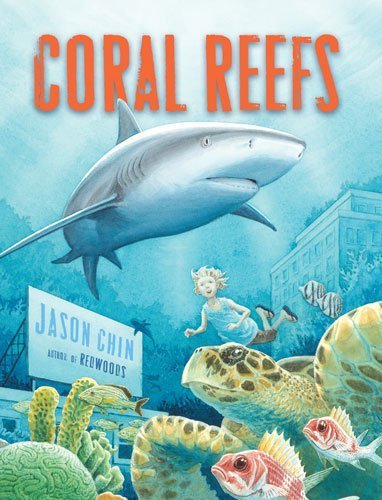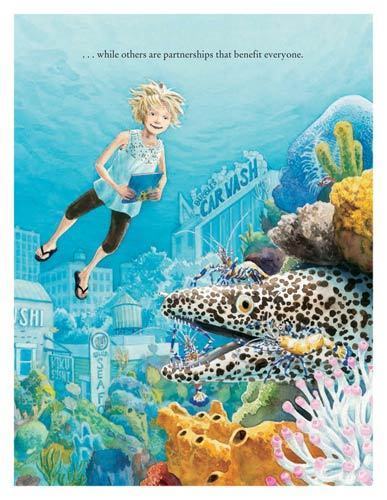Coral Reefs
By Jason Chin
Roaring Brook Press, 2011
ISBN: 978-1-59643-563-6
Nonfiction picture book with fantasy element
"For more than 400 million years, corals have been building reefs in the earth's oceans. Corals may look like plants, but they are actually animals. Some are soft and sway back forth in the water, while others, called hard corals, are rigid. Corals are made up of polyps, and most have hundreds of tiny polyps on their surface."
A young girl pulls a book off the shelf at the New York Public Library and begins to read. Like the boy carried into the forest in Redwoods, she is swept into the undersea world of corals. Before this happens, however, Chin presents some of the fascinating information about corals and the skeletons of these animals that form coral reefs. As the girl experiences slides into the coral reefs, she meets up with the plants and animals that live there.
Chin brings to life the brilliant colors and variety of animals living in the tropic seas where reefs are formed. Each spread presents information and brings what the child is reading to life. This book provides excellent information and makes the relationships among the life there clear and real.
This book slips into the undersea world more effortlessly than Redwoods. It's lovely and lush—and guaranteed to be popular, especially among New York librarians!
Activity 1
Create a food chain or web from the organisms in the book.
This site has a food chain explanation.
Activity 2
Look up the term for the relationship between two animals that is mutually beneficial called mutualism. Find other examples of beneficial relationships.
Here are two examples.
Activity 3
Find ways some of the animals have adapted to escape their predators using the book's information.
Visit my post on Follow That Food Chain Coral Reefs post to pair the books and find more activities.
National Science Standards: Interdependent Relationships in Ecosystems, Cycles of Matter and Energy Transfer in Ecosystems, Ecosystems Dynamics, Functioning, and Resilience
Book provided by Blue Slip Media and Macmillan Children's Publishing Group








Shirley Smith Duke's Blog





